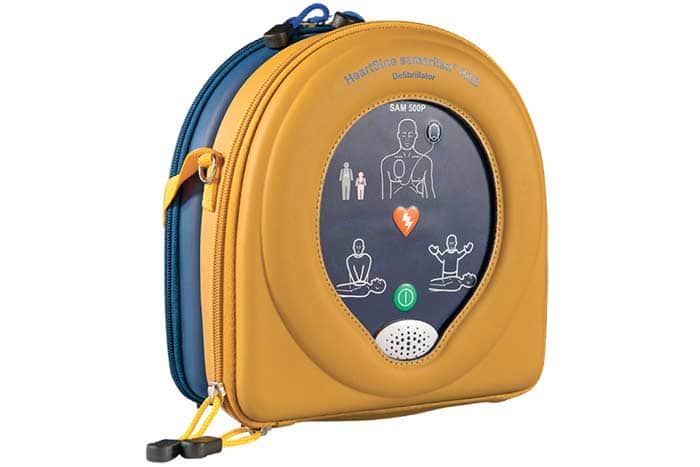According to statistics, around 20,000 Australians suffer a cardiac arrest outside a hospital every year and of those people, only 10% will survive. One of the most important pieces of medical technology around the world, a defibrillator is a device that gives a high energy electric shock to the heart of someone who is in cardiac arrest and is essential part in trying to save lives. At Safety Dave, we are the experts in safety equipment for homes and businesses across Australia and we supply the Defibrillator 500P – the only Automated External Defibrillator which provides CPR feedback based on assessment of patient. We want to ensure that anyone and everyone knows what defibrillators are, what they do and why they are so important. Read on to find out.
What Is Sudden Cardiac Arrest?
Not to be confused with a heart attack, sudden cardiac arrest occurs when heart function ceases abruptly and without warning. It is an electrical problem that creates an abnormal heart rhythm, preventing the heart from pumping blood to all vital organs. Sudden cardiac arrest is unpredictable and can happen anywhere, anytime, at any age, and without any warning. Time is of the essence in these situations and using a defibrillator is the only effective intervention that can provide the victim with the greatest chance of survival. Without treatment, a cardiac arrest victim’s chances of survival decrease by 10% per minute.
What is a Defibrillator?
Proven to be one of the most important tools in saving the life of someone suffering sudden cardiac arrest, a defibrillator, or AED (automated external defibrillator), is a small, lightweight, portable device that analyses a person’s heart rhythm, recognises irregular heart rhythms and delivers an electric shock through the chest wall of a person whose heart has stopped beating. Combined with the immediate application of cardiopulmonary resuscitation (CPR), a defibrillator is the only form of treatment for someone who has suffered a cardiac arrest. The defibrillator will only provide shock treatment to the heart if the organ is in a certain state of uncontrollable quivering, or ‘fibrillating’. If the unit detects the heart is not in a ‘shockable rhythm’, it will not allow the user to perform treatment. If used within 3-5 minutes of a person collapsing, their survival chances increase from 6% to 74%.
How to Use a Defibrillator
An incredibly easy piece of equipment to use, they’re designed to be used by any first responder, regardless of age, training or experience. Although they don’t all look the same, they all function in broadly the same way, emitting clear voice prompts and most have legible and visual instructions. The Defibrillator 500P also provides CPR feedback based on assessment of the patient. As the machine gives clear spoken instructions all you have to do is follow them.
Once you press the ON button or open the cover on an AED, it will guide you through the following process with clear voice prompts:
- Call 000
- Expose the chest
- Attach cables to electrode pads (with some models both are pre-connected)
- Make sure the chest is dry (the pads will adhere better to a smooth, dry surface)
- Peel away the protective plastic and attach the electrode pads
- Position a pad on the right upper anterior side of the person’s chest, just below the collarbone
- Position the second pad on the left lower anterior chest wall, just below the nipple (some electrodes have handy diagrams on them, showing you where they should be placed)
- Stand back and ensure no one is touching the individual
- Press the ANALYSE button on the defibrillator and follow the voice prompts (some machines automatically analyse when the pads are applied)
- Once the machine has analysed the heart rhythm, it will indicate via voice control whether or not a shock is required
- If shock is required, push the flashing shock button. Some AEDs will automatically shock the casualty without the need to push a button
- The defibrillator will tell you when the shock has been delivered and whether you need to continue CPR
- Continue with chest compressions and rescue breaths until the patient shows signs of life or the defibrillator tells you to stop so it can analyse the heartbeat again
Defibrillators save lives. With over 20 years’ experience within the safety industry, at Safety Dave, our Defibrillator 500P may be compact in size but it is big in ability. If you want to make sure you have access to the best safety equipment for your home or business, get in touch with us today on 1800 072 338 or contact us online for more information.


